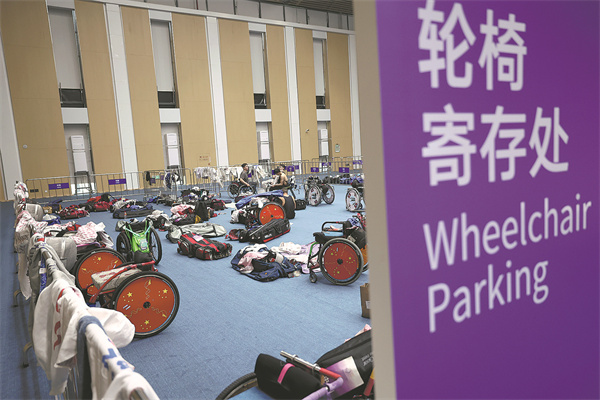
Wheelchairs are parked in the gym at Hangzhou Dianzi University. [Photo/China Daily]
'Touching, inspiring'
Having opened on Oct 22, the weeklong games ended in Hangzhou on Saturday. They were seen as a "touching and inspiring" event because of the performances of the competitors and the excellent barrier-free services provided by staff members and volunteers, said Chen Weiqiang, Hangzhou Asian Para Games chief spokesperson, at a recent news briefing.
"Hangzhou spent five years preparing for the games and made thorough plans for transportation, accommodations and medical services for competitors and their escorts," he said.
As of Friday, the city had offered arrival and departure services to 7,624 people involved in the games, while the number of people who used the athletes' village peaked at 5,002 on Oct 23, the first competitive day.
According to the organizers, the village offered about 1,100 barrier-free beds and had dedicated dining areas for wheelchair users. Barrier-free services, such as wheelchair-charging poles and maintenance for assistive devices, were also available in the facility.
The 29 event-designated hotels in Hangzhou's downtown also optimized their barrier-free facilities and services. For example, the Hangzhou Grand Metropark Hotel transformed about 20 rooms into barrier-free zones, with bed heights lowered to 40 centimeters to allow wheelchair users to move themselves on and off the mattresses.
In 2020, Hangzhou published a three-year action plan for the promotion of a barrier-free environment. The aim was to make the city a state-of-the-art zone with sound facilities, standards and shared information to embrace the games by last year, the original scheduled date for the event, before it was delayed because of the COVID-19 epidemic.
Under the plan, city-level regulations on the construction and management of barrier-free facilities were revised. Meanwhile, plans were drawn up for a barrier-free environment in accordance with international experience to provide more legislative and policy-related support for the work.
In addition to infrastructure facilities, the plan focused on the optimization of online barrier-free services — for example, adding sign language interpretation to television programs and transforming life-services platforms, such as e-mapping and e-commerce, via disabled-friendly functions.
According to Pan Yan, director of the Jiashanlu Street Committee, from March onward, the body spent nearly 50,000 yuan to optimize the related environment at its community services center, including wheelchair ramps, barrier-free restrooms and assistive devices.
"Our community has 13 residential clusters of 5,000 households, and about 90 residents have physical or mental disabilities. The barrier-free facilities are open to everyone, not just local residents," she said.
"I've worked in the community for 20 years, and I feel the public has drawn more attention to the care of disabled people and helped create a friendlier environment for them."